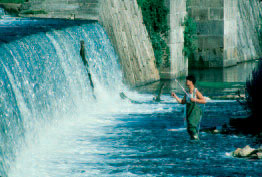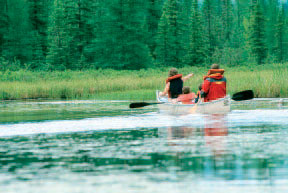Means of implementing protective measures
5. Protection and Management of the Property
- Ownership
- Protective designation
- Means of implementing protective measures
- Existing plans related to municipality and region in which the proposed property is located
- Property Management Plan
- Sources and levels of finance
- Sources of expertise and training in conservation and management techniques
- Visitor facilities and statistics
- Policies and programmes related to the presentation and promotion of the property
- Staffing levels
C. Means of implementing protective measures
The Government of Canada is the sole owner of all the elements of the nominated property and the land on which they are situated. It also owns the bed of the watercourse of the Rideau Canal up to the controlled high water elevation on the shore. The nominated property is protected by a federal planning and regulatory framework, but lands beyond its boundaries fall under provincial and municipal jurisdictions. Accordingly, cooperative strategies are required and used to manage environmental and land-planning issues. The Government of Canada, through the Parks Canada Agency, works with municipal and provincial organizations to ensure the effective management of development adjacent to the nominated property. While each level of government has distinct areas of jurisdiction and responsibility, the overall result is an effective system of protection for the property.
Role of the Government of Canada
Pursuant to the Parks Canada Agency Act , detailed direction for the agency’s management of its responsibilities to commemorate, acquire and administer historic places is provided in the agency’s Guiding Principles and Operational Policies . The act also requires that each national historic site have in place a management plan approved by the Minister responsible for the Parks Canada Agency. As directed in the Guiding Principles and Operational Policies , a management plan identifies long-term programs to ensure the commemorative integrity of the site through the protection and presentation of the cultural heritage values for which it was commemorated. These values are identified in a commemorative integrity statement, which is the precursor of the management plan.
The Rideau Canal Management Plan was completed in 1996 and updated in 2005. Management plans for Fort Henry and the Kingston Fortifications are nearing completion. The Superintendent of the Eastern Ontario Field Unit is delegated the responsibility for developing, implementing and periodically reviewing management plans.
While the Rideau Canal Management Plan is a tool for long-term management of the canal, the Historic Canals Regulations provide an enforcement mechanism to regulate activities that could harm its cultural values. The regulations provide for permits for activities such as dredging and the construction of marine works on the bed of the canal, and fines and other penalties for contraventions of the regulations. In addition, the Navigable Waters Protection Act (1985), administered by the Department of Transport, ensures that any construction activities on or over the canal do not alter or impair the watercourse.
Role of the Province of Ontario
The Province of Ontario contributes to the protection of the lands adjacent to the nominated property through legislation dealing with land-use planning and cultural heritage and environmental protection.
The Planning Act (1990) provides direction for municipal land-use planning in Ontario, to ensure that the province’s interests are adhered to when local plans are formulated. Matters of interest include the protection of natural and cultural heritage, environmental protection, and appropriate development and growth.
The Province of Ontario provides a framework for protecting cultural resources through the Ontario Heritage Act (1990) . This act empowers municipalities to designate buildings, landscapes and archaeological features possessing historic value, and to provide assistance to local heritage interests in implementing programs for inventory and designation. Through this act, municipalities have designated numerous buildings along the Rideau Canal.
 Fishing remains a popular activity along the Rideau Canal because of good wildlife management practices. © Parks Canada |
The Province of Ontario administers the Fish and Wildlife Conservation Act , the Environmental Protection Act, the Endangered Species Act and the Provincial Parks Act . These acts provide for the management and protection of the fish and wildlife resources of Ontario, and regulate water quality, the conservation of threatened species of flora and fauna, and the establishment and management of provincial parks. They are implemented through regulations and through a variety of programs administered by provincial agencies. These legislative mechanisms make an important contribution to the overall environmental quality of the Rideau Canal. For example, the regulations to protect water quality require substantial setbacks from the shoreline for new development. This measure not only protects water quality but also the natural character of the shoreline, which contributes to the heritage character of the Rideau Canal. As well, measures to protect fish, wildlife and threatened species include the protection of their habitats, such as wetlands and undeveloped shore lands, both of which are important components of the canal.
Role of Conservation Authorities
 The extensive wetlands along the Rideau Canal are an important part of the area’s natural values. © Parks Canada |
Conservation authorities are mandated under the Conservation Authorities Act (1990) to ensure the conservation, restoration and effective management of Ontario’s water resources, wetlands, woodlands and natural habitats. There are two conservation authorities with jurisdiction in the area of the Rideau Canal, the Cataraqui Region Conservation Authority, encompassing the Cataraqui River watershed from Newboro Lake to Kingston, and the Rideau Valley Conservation Authority, extending from Upper Rideau Lake to Ottawa. The conservation authorities provide a valuable function in protecting the nominated property and adjacent lands by regulating development along the shore and through programs to conserve wetlands, woodlands and natural habitats.
Role of Municipalities
Municipalities in Ontario have full authority over land-use planning and development by virtue of the Planning Act , which requires the preparation of official plans and zoning bylaws. Municipalities have the authority to enforce the provisions of zoning bylaws through fines and other mechanisms, so that land use and development areconsistent with the municipality’s official plan.
The most important aspect of managing the setting of the Rideau Canal relates to the immediate intersection of the nominated property and private property at the shoreline of the navigable watercourse of the canal. Municipal planning policies protect the integrity of the shoreline and the natural character of the shore lands, and severely restrict the location, type and scale of development. The most effective municipal landuse policy is the requirement for frontage of between 50 m to 75 m for development lots and a setback of 30 m from the shoreline. This mandatory 30 m setback constitutes the buffer zone for the canal element of the nominated property. In the rural areas, comprising most of the shoreline of the nominated property, generally only single-family residences are allowed, and they must be screened from view so as to be largely hidden from the canal. Additional regulations protect floodplains, wetlands, and other natural features, thereby further reducing the impact of development.
The Parks Canada Agency participates directly in the development of municipal official plans and their associated policies. All official plans for the municipalities bordering the nominated property have specific policies pertaining to the protection of heritage. When official plans are developed and reviewed, a highly cooperative inter-jurisdictional approach is employed to ensure that the resulting plans and policies meet the requirements of all levels of government.
Through the Ontario Planning Act , the Parks Canada Agency has the right to intervene in proposed development applications should it believe that the development will, in any way, negatively affect the nominated property. The act establishes the Ontario Municipal Board, to which appeals may be made should a development application be construed as a threat to a neighbouring property. Although the occasions when this has been required have been rare, the Parks Canada Agency has made successful interventions related to proposed developments.
- Date modified :